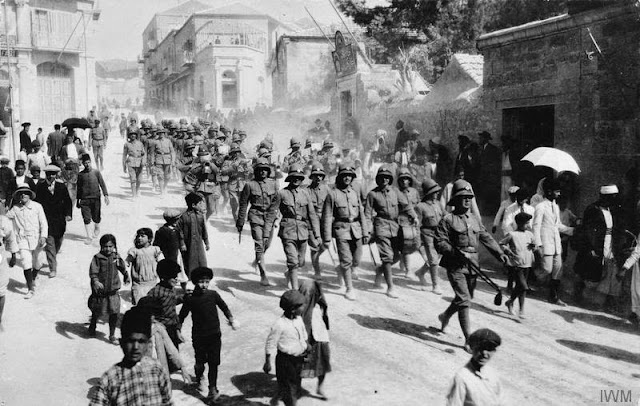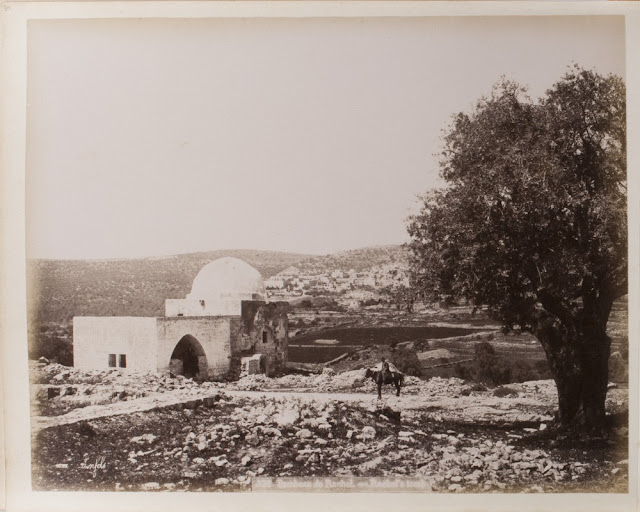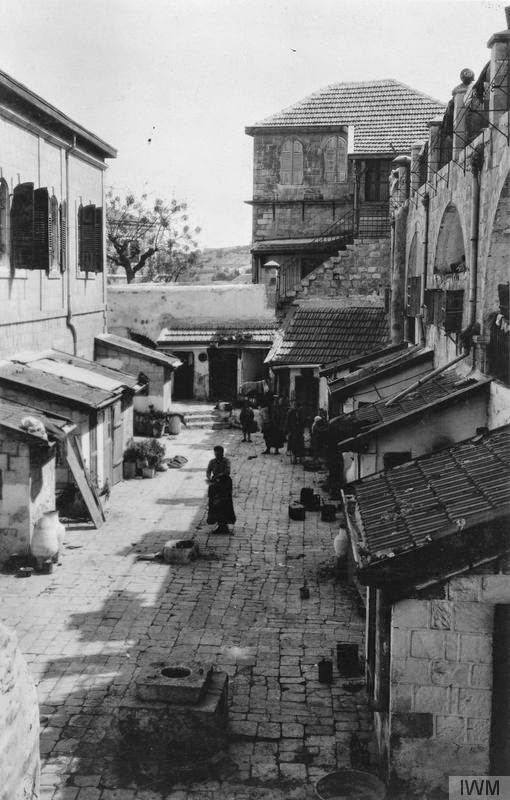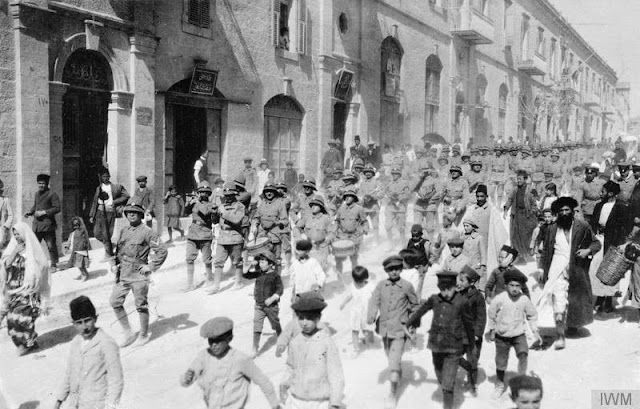Israel's History - a Picture a Day (Beta)
WWI: Were Jewish Soldiers in the British Army Permitted to Celebrate Passover in Jerusalem in 1918?Posted: 01 Apr 2015
Individual Jewish soldiers served in the ranks of the armies of Great Britain, Australia and New Zealand and were involved in the 1917 battles in locations such as Be'er Sheva and Rishon LeZion. Another large group of Jews served in the British army's Jewish Legion, commanded by Col. John Henry Patterson and involved in combat after arriving in Palestine in 1918. According to
Patterson's memoirs, 2,000 soldiers were under his command.
Patterson bitterly complained that his soldiers were forbidden from celebrating Passover in Jerusalem in 1918 and 1919, yet the pictures below show Jewish soldiers in Jerusalem on the holiday. How can the contradiction be explained?
 Jewish soldiers from various British units celebrating Passover in Jerusalem, 1918. The various headgear suggests the soldiers were from many army units, including ANZAC and Scottish, and not necessarily from the Jewish Legion.. (Harvard Library/Central Zionist Archives)
Jewish soldiers from various British units celebrating Passover in Jerusalem, 1918. The various headgear suggests the soldiers were from many army units, including ANZAC and Scottish, and not necessarily from the Jewish Legion.. (Harvard Library/Central Zionist Archives)
In Patterson's own words, the new sovereign of Palestine -- the British army -- continued the Ottomans' anti-Semitic practices against the Jews. Patterson's fury could barely be contained when his Jewish soldiers suffered from vicious anti-Semitism within the army and from British commanders.
 Col. John Henry Patterson
Col. John Henry PattersonPalestine has become the theatre of an undisguised anti-Semitic policy. Elementary equality of rights is denied the Jewish inhabitants; the Holy City, where the Jews are by far the largest community, has been handed over to a militantly anti-Semitic municipality; violence against Jews is tolerated, and whole districts are closed to them by threats of such violence under the very eyes of the authorities; high officials, guilty of acts which any Court would qualify as instigation to anti-Jewish pogroms, not only go unpunished, but retain their official positions.
The Hebrew language is officially disregarded and humiliated; anti-Semitism and anti-Zionism is the fashionable attitude among officials who take their cue from superior authority; and honest attempts to come to an agreement with Arabs are being frustrated by such means as penalising those Arab notables who betray pro-Jewish feeling.
The Jewish soldier is treated as an outcast. The hard and honest work of our battalions is recompensed by scorn and slander, which, starting from centres of high authority, have now reached the rank and file, and envenomed the relations between Jewish and English soldiers. When there is a danger of anti-Jewish excesses, Jewish soldiers are removed from the threatened areas and employed on fatigues, and not even granted the right to defend their own flesh and blood.
Discrimination against Jews was, however, still shown in other quarters. Early in April 1918 the men were considerably upset on the receipt of orders from G.H.Q. that no Jewish soldier would be allowed to enter Jerusalem during the Passover; the order ran thus: "The walled city (of Jerusalem) is placed out of bounds to all Jewish soldiers from the 14th to the 22nd April, inclusive."
 The caption reads: "Jewish Legion soldier (sic) during Passover in Jerusalem." Clearly, this is not Jerusalem. The library description of the photo also includes "Judean Hills region," a more likely setting. (Harvard Library/Central Zionist Archives)
The caption reads: "Jewish Legion soldier (sic) during Passover in Jerusalem." Clearly, this is not Jerusalem. The library description of the photo also includes "Judean Hills region," a more likely setting. (Harvard Library/Central Zionist Archives)
I cannot conceive a greater act of provocation to Jewish soldiers than this, or a greater insult. The days during which they were prohibited from entering Jerusalem were the days of the Passover. Think of it! Jewish soldiers for the first time in their lives in Palestine and barred from the Temple Wall of Jerusalem during Passover! Only a Jew can really understand what it meant to these men, and the great strain it put on their discipline and loyalty.
How provocative and insulting this order was will be better understood when it is realized that the majority of the population of Jerusalem is Jewish, and, therefore, there could have been no possible reason for excluding Jewish troops belonging to a British unit, while other British troops were freely admitted, more especially as the conduct of the Jewish soldiers was, at all times, exemplary.
 Jewish soldiers at Passover Seder, Jerusalem, 1919 The photo is signed by Ya'akov Ben-Dov who moved to Palestine in 1907 from Kiev. He was drafted into the Ottoman army during World War I and served as a photographer in Jerusalem. Ben-Dov filmed Allenby's entry into Jerusalem in 1917. (Harvard Library/Central Zionist Archives)
Jewish soldiers at Passover Seder, Jerusalem, 1919 The photo is signed by Ya'akov Ben-Dov who moved to Palestine in 1907 from Kiev. He was drafted into the Ottoman army during World War I and served as a photographer in Jerusalem. Ben-Dov filmed Allenby's entry into Jerusalem in 1917. (Harvard Library/Central Zionist Archives)Not since the days of the Emperor Hadrian had such a humiliating decree been issued. However, to make up somewhat for the action of the authorities, I made arrangements for the Passover to be observed at Rafa with all the joy and ceremony usually attending that great Feast of the Jewish People. At considerable cost we provided unleavened bread, as well as meat and wine—all strictly "Kosher."
As we were nearly 2,000 strong at this time, the catering for the feast had to be most carefully gone into, and Lieut. Jabotinsky, Lieut. Lazarus, and the Rev. L. A. Falk did yeoman service in providing for all needs. It was a wonderful sight when we all sat down together and sang the Hagadah on the edge of the Sinai desert.
Passover was selected to insult their deepest religious feelings, by barring them access to the Wailing Wall during that week. No Jewish detachment is allowed to be stationed in Jerusalem or any of the other Holy Cities of Jewry.
.
 Jewish soldiers -- their headgear and uniforms suggests they are from from various units -- celebrating Passover at the British Jewish Soldiers Home in Jerusalem, 1919 (Harvard Library/Central Zionist Archives)
Jewish soldiers -- their headgear and uniforms suggests they are from from various units -- celebrating Passover at the British Jewish Soldiers Home in Jerusalem, 1919 (Harvard Library/Central Zionist Archives)
The Feast of the Passover was celebrated during our stay at Helmieh. Thus history was repeating itself in the Land of Bondage in a Jewish Military Camp, after a lapse of over 3,000 years from the date of the original feast.
I had considerable trouble with the authorities in the matter of providing unleavened bread. However, we surmounted all difficulties, and had an exceedingly jovial first night, helped thereto by the excellent Palestinian wine which we received from Mr. Gluskin, the head of the celebrated wine press of Richon-le-Zion, near Jaffa. The unleavened bread for the battalion, during the eight days of the Feast, cost somewhat more than the ordinary ration would have done, so I requested that the excess should be paid for out of Army Funds. This was refused by the local command in Egypt, so I went to the H.Q. Office, where I saw a Jewish Staff Officer, and told him I had come to get this matter adjusted.
He said that, as a matter of fact, he had decided against us himself. I told him that I considered his judgment unfair, because the battalion was a Jewish Battalion, and the Army Council had already promised Kosher food whenever it was possible to obtain it, and it would have been a deadly insult to have forced ordinary bread upon the men during Passover.
I therefore said that I would appeal against his decision to a higher authority. He replied, "This will do you no good, for you will get the same reply from G.H.Q." He was mistaken, for I found the Gentile, on this particular occasion, more sympathetic than the Jew, and the extra amount was paid by order of the Q.M.G., Sir Walter Campbell.
It is apparent that while Jewish soldiers from other units in the British army were permitted to attend seder in Jerusalem, the formal Jewish Legion was not, perhaps because of the army's desire to restrict a distinctly Jewish, nationalistic corps in its midst.
 Pictures from the German Army March in 1917 Are Matched by a Reader to Today's Jaffa Road
Pictures from the German Army March in 1917 Are Matched by a Reader to Today's Jaffa RoadPosted: 01 Apr 2015
Bravo to Simon, a reader of Israel Daily Picture, who provided these contemporary pictures showing the exact locations where German soldiers marched in Jerusalem during World War I.
Simon even recreated the exact photo angles.
Stay tuned. More mystery pictures from World War I will be appearing here.
 German soldiers marching in Jerusalem on Good Friday, Passover Eve, 1917 on Jaffa Road
German soldiers marching in Jerusalem on Good Friday, Passover Eve, 1917 on Jaffa Road The exact spot on Jaffa Road 98 years later, the same doorways, balconies.
The exact spot on Jaffa Road 98 years later, the same doorways, balconies. German soldiers marching in Jerusalem on Good Friday, Passover Eve, 1917 in front of the Fast Hostel, where the Dan Pearl Hotel is located today.
German soldiers marching in Jerusalem on Good Friday, Passover Eve, 1917 in front of the Fast Hostel, where the Dan Pearl Hotel is located today. The 1917 buildings have been replaced, but this is the spot where the German army marched.
The 1917 buildings have been replaced, but this is the spot where the German army marched.Simon wrote, "It's fascinating how in one picture the scene is little changed, apart from the modern shop signs and the light rail tracks down the street, but in the other picture nothing from 1917 is still there in 2015 -- even most of the street itself has been replaced by an underpass."















































